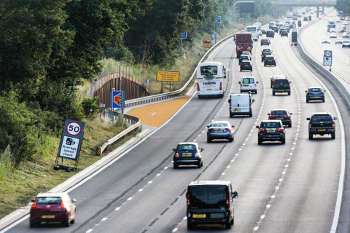Highways England is ‘struggling to understand’ the recent controversy over the safety of all lane running ‘smart motorways’, its chief executive has said.
Jim O’Sullivan (pictured) was speaking at a conference after it emerged that the widow of a driver who was killed after stopping in a live lane on a smart motorway plans to bring a case against the government-owned company for corporate manslaughter.
He said: ‘I do find it hard to understand the gap between what we have done on smart motorways to make them safe and keep them safe and the perception that they aren’t safe that is often expressed in the newspapers and by some of the motoring organisations.
‘We know the accident rates on smart motorways are no different from conventional motorways. Both are amongst the safest roads in the world. They’re about ten times safer than normal built-up roads.’
Mr O’Sullivan pointed out that one in ten fatalities on motorways occurs on the hard shoulder, which under all lane running is permanently or temporarily turned into a live lane .
He said: ‘We’re working hard; we’re comparing the types of accidents on both types of motorways. And we’re comparing the numbers. We can find no perceivable difference. So when we find no perceivable difference we look again. But much of this press, we are struggling to understand it.’
Highways England has been criticised for extending the gap between emergency refuge areas [ERAs] on recent schemes and a delay in implementing a pledge to make them closer together on some existing and future schemes.

A brightly painted ERA on the recent M3 smart motorway
In response to a question from the floor, Mr O’Sullivan said: ‘We are content with the design of the smart motorways that are coming into production, in particular I think the biggest scheme is the M4. We have data which says putting the refuge areas closer together makes people feel safer but it doesn’t seem to actually reduce accidents.’
‘There seems to be no correlation between the spacing of the ERAs and the live lane breakdown risk. It’s highly counter-intuitive but that’s what we are seeing.’
As Transport Network has reported, some campaigners, including the AA, have suggested that money from speeding fines on smart motorways should be spent on extra ERAs.
Mr O’Sullivan said: ‘In truth, it would be hugely expensive to go back and change the spacing on the M4 because a) it’s in build and b) it’s in design and I’d rather spend money on safety on other aspects.
'One of the biggest single innovations in recent years that has made a huge difference to the safety of any road is concrete central reservation. It costs about a million pounds a mile, more than steel barrier. And given the choice of where to spend safety money, every time I would spend it on concrete central reservation, rather than emergency refuge areas.'
He added: ‘We are going to retrofit some for the M25. It will be interesting to see if they reduce the live lane breakdowns on the M25.’
Register now for full access
Register just once to get unrestricted, real-time coverage of the issues and challenges facing UK transport and highways engineers.
Full website content includes the latest news, exclusive commentary from leading industry figures and detailed topical analysis of the highways, transportation, environment and place-shaping sectors.
Use the link below to register your details for full, free access.
Already a registered? Login